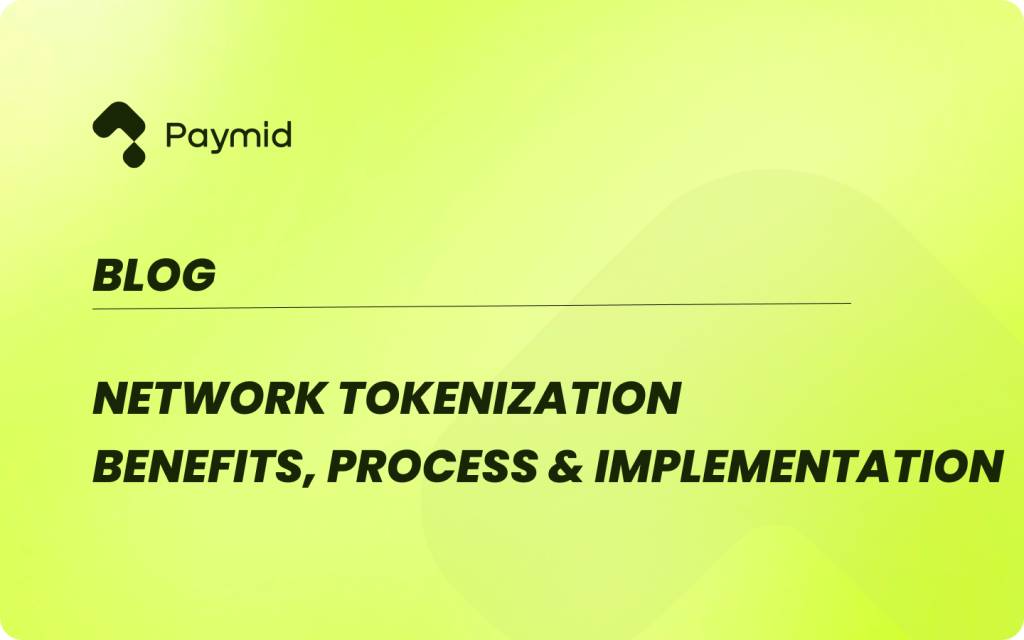Network Tokenization: Benefits, Process & Implementation

Network tokenization is causing a revolution in how businesses protect sensitive financial data, offering a robust solution to combat the rising tide of data breaches and cyber threats.
Network tokenization is a type of payment tokenization where the payment network acts as the token service provider (TSP) to generate tokens [1].
It’s a security measure that replaces sensitive payment card data, specifically the primary account number (PAN), with a unique identifier called a token [2]. This approach enhances the underlying security of digital payments by substituting PANs with distinct EMV payment tokens.
⚡ Key Takeaways
Read More:
- How To Implement Multi-Channel Payments For Your Business?
- Merchant Acquirer vs Payment Processor: A Detailed Comparison
- What Does Payment Revision Mean? [Quick Fixes]
- Payment Optimization For Business [Everything To Know]
How Network Tokenization Works
The process of network tokenization involves exchanging sensitive cardholder data, such as the PAN, for a non-sensitive placeholder called a token. This token offers the same functionality as the original data without the associated risk.
The key difference between network tokenization and other forms of tokenization is that network tokens are issued by the card brands themselves, allowing them to be used at each step of the payment process.
Network tokens can be restricted in their usage, for example, to a specific device, merchant, transaction type, or channel. This adds an extra layer of security to the payment process. Additionally, if the underlying PAN associated with a network token changes or expires, the token will remain current and usable.
This feature reduces the number of charges declined due to outdated credentials, increasing authorization rates, particularly on frequently used cards like subscription payments.
Comparison with traditional tokenization
Traditional tokenization solutions, also known as security tokenization or acquirer tokenization, have been used to protect cardholder data and personally identifiable information (PII) stored in merchant databases.
However, network tokenization offers several advantages over these traditional methods:
- Enhanced security: Network tokenization protects card details throughout the entire transaction lifecycle, making it inherently more secure.
- Global interoperability: Network tokens can be used across multiple acquirers and gateways, providing consistency across different acceptance environments.
- Seamless integration: Network tokens are in the same format as a regular PAN, allowing them to be accepted and routed along normal payment rails without impacting existing merchant systems[2].
- Cost-effectiveness: Network tokens can often be more cost-effective than traditional tokens or PANs for card transactions [3].
- Additional features: Network tokenization offers more than just security. It can enhance the buying experience through digital card art, instant card detail refreshes, and push provisioning.
Benefits of Network Tokenization
1. Enhanced Security
Network tokenization significantly improves payment security by replacing sensitive card data with unique, encrypted tokens. These tokens are specific to each business, making them useless if intercepted by fraudsters.
This approach minimizes the risk of exposing customers’ sensitive card information, as tokens are passed around instead of raw card details. The result is a substantial reduction in the risk of payment card fraud and data theft.
2. Improved Authorization Rates
One of the most significant advantages of network tokenization is its ability to boost authorization rates. Visa reports that merchants using its tokens see an average 2.1% authorization rate uplift for card-not-present transactions [4].
This improvement stems from issuers having more confidence in the transaction’s authenticity when a network token is used [5]. Additionally, network tokens remain current and usable even if the underlying PAN changes or expires, reducing declines due to outdated credentials [6].
3. Reduced Fraud
Network tokenization has a profound impact on fraud reduction. According to Visa, the 4 billion network tokens it has issued to date have resulted in a 28% reduction in fraud rates [7].
This significant decrease in fraud occurrences is due to the unique, merchant-specific nature of network tokens, which renders them inoperable if stolen.
4. Cost Savings
Implementing network tokenization can lead to substantial cost savings for businesses. Many card networks, including Visa and Mastercard, offer lower interchange fees for transactions processed with network tokens. Furthermore, network tokenization can help reduce expenses associated with fraud prevention and data security compliance [8].
5. Better Customer Experience
Network tokenization enhances the customer experience by streamlining the payment process. It enables seamless transactions by automatically updating card details when changes occur, eliminating the need for customers to manually update their information [9].
This feature particularly benefits recurring payments and subscriptions, reducing involuntary churn and ensuring uninterrupted service. The improved security and higher approval rates also contribute to a smoother, more reliable payment experience for customers.
How Network Tokenization Works
Token Provisioning Process
Network tokenization begins with the token provisioning flow. When a cardholder enters their card information during checkout or card storage, the data is passed to parties registered with card schemes for network tokenization. These parties can include merchants, third-party token vault providers, gateways, PSPs, or acquirers.
The card network then creates a network token and sends it to the issuer (cardholder’s bank) and the PSP. This token, along with a cryptogram, can be used in the authorization process. The registered parties return the network token to the merchant, who can store it for future purchases with the same card.
Transaction Flow
For transactions using network tokens, the process differs slightly from traditional methods:
- The client sends payment authorization to the payment gateway with the network token and cryptogram.
- The payment gateway passes the authorization to the payments network.
- The issuer approves the payment transaction.
For merchant-initiated transactions, only the network token is needed. However, customer-initiated transactions require a new cryptogram, which the merchant must retrieve using the registered third party.
Role of Card Networks and Issuers
Card networks play a crucial role in network tokenization. They generate tokens in real-time during online transactions [10]. The networks also maintain the mapping of cardholder information to network tokens, updating it on the backend if changes occur.
Issuers participate in the tokenization process to securely provision tokens on devices in partnership with card networks and wallet providers. This involvement ensures that the card holder’s credentials remain current, even if a physical card is locked due to fraud.
By implementing network tokenization, merchants benefit from enhanced security, improved customer experience, and increased authorization success rates. This technology effectively removes the need for merchants to handle sensitive card information directly, reducing their exposure to risk [11].
Implementing Network Tokenization
Implementing network tokenization presents several challenges for merchants. One key issue is the need to capture and vault primary account numbers (PANs) before provisioning network tokens [12]. This process can take a few seconds, which is a considerable time in the payments world. Additionally, not all issuers, acquirers, and payment service providers have adopted network tokens universally [13].
Token lifecycle management is another hurdle. Tokens have expiration dates and can be suspended or deactivated, requiring careful tracking.
Merchants must also consider how to handle card details during implementation to ensure smooth chargeback reconciliation, which typically takes 30-60 days to process.
Best Practices
To navigate these challenges, merchants should consider the following best practices:
- Data-driven approach: Gather data to identify specific reasons for declined transactions and quantify the anticipated improvement in authorization rates.
- Retain PANs: Maintain PANs alongside network tokens as a fallback mechanism for the foreseeable future.
- Partner with service providers: Work with providers offering token-related solutions to simplify the process of adopting and using network tokens [14].
- Ensure continuity: Tokenize existing negative or positive customer lists to maintain fraud prevention levels and customer experience.
- Retain crucial data: Keep the bank identification number (BIN) for effective real-time screening and fraud detection.
Future of Payment Security
The future of payment security lies in the widespread adoption of network tokenization. With global, cross-industry backing and deployment in over 193 countries, network tokenization is poised for mainstream adoption [15]. As more merchants experience success with this technology, its adoption is likely to accelerate.
Network tokenization offers enhanced security through cryptograms, which tie payment attempts directly to specific merchants and tokens. This improved security is a major factor in boosting authorization rates and reducing fraud.
As the technology evolves, we can expect to see more seamless and frictionless transactions for customers, potentially making payments both secure and invisible – the ultimate goal of payment consumer experience [16].
Is Network Tokenization Worth It?
Network tokenization is changing the game in payment security. It offers stronger protection for sensitive data, boosts authorization rates, and cuts down on fraud. This technology isn’t just about security – it also makes life easier for customers and can save businesses money. As more companies start using network tokens, we’re likely to see a big shift in how digital payments are handled.
Looking ahead, network tokenization is set to become a key player in the world of payment security. Its ability to make transactions both secure and smooth paves the way for a future where payments could become almost invisible. As the tech keeps evolving, we can expect to see even more innovative ways to keep our digital transactions safe and easy.

